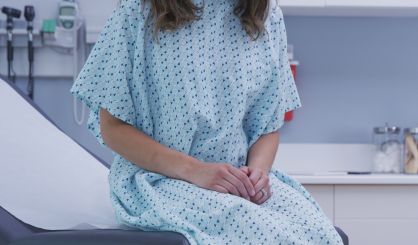
“We had hoped the decision would come down on one of the days we were not doing procedures,” Dr. Sanithia Williams said. “We had a waiting room full of people. People were horrified and desperate. There were people crying. There were people begging. Some people offered to pay extra if we could just do the procedure-not fully understanding what was happening. We had to turn all those people away.
“To know that you have the skills to provide care at that moment and make such a difference in their life-something they have asked for-and the state has decided that [it knows] best. It was a really hard day.”
Fighting back tears, WIlliams, an ob-gyn and abortion provider in northern Alabama, recalls the day the U.S. Supreme Court handed down the decision that overturned Roe v. Wade. It was the same day the state’s abortion ban went into effect-a law that allows no exception for rape or incest or lethal fetal anomaly and carries a sentence of life in prison for doctors who perform the procedure.
The Alabama clinic where she worked has since closed its doors. The state now sits in the middle of what is known as an abortion desert-where people need to travel 100 miles or more, one way, to reach an abortion facility; where abortion access is virtually inaccessible.
Mississippi, the neighboring state at the center of Dobbs v. Jackson Women’s Health Organization, the case that dealt the final blow to Roe, has a total abortion ban with an exception for rape-but not incest.
Louisiana, Arkansas, Tennessee and Texas have total abortion bans with zero exceptions for rape or incest.
Georgia and South Carolina have six-week bans, and Florida has a 15-week ban.
According to the Guttmacher Institute, a leading research and policy organization on sexual and reproductive health, at the start of this month, 66 clinics across 15 states have been forced to stop offering abortions. These 15 states-all in the South and the Midwest-were enforcing either total or six-week abortion bans as of Oct. 2
In Ohio, where abortion is banned at six weeks with few exceptions, doctors are not only grappling with the impact of the Dobbs decision on women’s health and lives, but also on their own decision-making around abortion care.
“It has become devastating to practice medicine,” said Dr. Ellie Ragsdale, an ob-gyn who specializes in high-risk obstetrics and fetal therapy at an academic medical center in Cleveland. “You come to work every day and hope that the decisions you make are the best decisions for your patients, and that those decisions don’t land you in jail.”
Many worry that in this post-Roe landscape, women will die because they are too sick to carry a pregnancy to term.
“We have seen women who had major medical care morbidities when their life was at risk by pregnancy who had to leave our state to have a termination,” Ragsdale said. “We have seen patients who had lethal fetal malformations-babies who had no chance to survive outside the womb-who had to leave our state for a termination.”
Research shows that despite the frequency with which women have abortions in the U.S., it is the only type of healthcare that requires such a large number of individuals to leave their state to obtain care. For those living in Ohio, the median distance at press time to access abortion is 162 miles, plus another 162 miles to get back home.
“Gas prices are incredibly expensive right now. [For] plenty of folks, gas is the reason they can’t access their care,” said Maggie Scotece, the interim executive director of the nonprofit Abortion Fund of Ohio, the only statewide abortion fund in Ohio. Scotece said she is encouraged, though, by how many people have stepped up to offer their support, including donations for the cost of the procedure, as well as assistance for childcare, lodging and transportation.
In Michigan, one of the few Midwestern states where abortion remains legal, Planned Parenthood told NPR that since Roe was overturned, three times as many out-of-state patients seeking abortion care have arrived at their clinics.
“I work in a hospital and an outpatient setting. [Before Dobbs,] I might see 10 to 28 patients a week who are from out of state; instead we’re [now] seeing 50 to 60,” said Dr. Lisa Harris, a professor of obstetrics and gynecology and associate chair of the Department of Obstetrics and Gynecology at the University of Michigan.
Harris said women and other pregnant people are coming from Ohio, Wisconsin, Indiana, Kentucky and Texas. “The laws are certainly not stopping many people from ending their pregnancies; it’s just making it more difficult for them to do that.”
One solution is to expand the use of abortion pills, which can be safely self-administered until the 11th week of pregnancy. But while courts have ruled that banning medication abortion is unconstitutional, this has not stopped a wave of restrictive state laws limiting access to this effective, nonsurgical method. According to Guttmacher, “29 states now require that clinicians who administer medication abortion be physicians; two states prohibit medication abortion after a specific point early in a pregnancy; and 19 states require the clinician providing a medication abortion to be physically present when the medication is administered, prohibiting the use of telemedicine to prescribe medication for abortion.”
Meanwhile, major medical institutions, including the World Health Organization; the National Academies of Sciences, Engineering, and Medicine; and the National Abortion Federation, have found that mid-level providers, such as physician assistants and advanced practice nurses, can safely provide medication abortion-and they can do so by mail.
Harris said barriers to obtaining abortions compound problems faced by women of color, particularly Black women, whose maternal mortality rate is three times the rate for white women, according to the Centers for Disease Control and Prevention. She asserts that because of the way racism intersects with economic inequity, as well as decreased access to healthcare and racism in medical systems, it is vital that every part of this issue is viewed through a racial equity lens.
“It means that women of color, including Black women, have less access to contraception in the first place, less access to healthcare in general, which means they are more likely to have an untreated underlying health issue or chronic illness,” Harris said.
In addition to economic insecurities, Harris said Black women are more likely to face criminal penalties for self-managed abortions.
The criminalization of abortion alarms reproductive justice advocates like Janette Robinson Flint, executive director of Black Women for Wellness, a woman-centered, community-based organization in Los Angeles. Flint said for women and other pregnant people who experience intimate partner violence, abortion bans are dangerously harmful.
She recalled the story of a woman who chose to have an abortion after she realized she could not face a fourth pregnancy with a man who physically abused her, a man who was careful to ensure that she showed no visible signs of his ongoing abuse.
“You don’t know what happens behind closed doors,” Flint said. “We are talking now about laws that will weaponize pregnancy, which will give weapons to abusers who can threaten you with that pregnancy. They can threaten to send you to jail; they can threaten you with more physical harm.”
Beyond abortion, health services overall are at risk, with the loss of abortion care creating repercussions along the full range of reproductive health services.
“When clinics close their doors, we lose access to birth control, pap smears, HIV and STI screening; we lose mammograms as well as prenatal care. … It puts an interesting burden on women who seek services,” Flint said.
She said this post-Roe landscape requires a different approach, and more people are being called upon to be revolutionaries. This includes medical providers.
“Doctors are going to have to figure out how to be bold and audacious,” she said. “They are going to have to be not afraid to offer services, and absolutely not report women’s data.”






